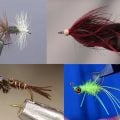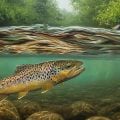How to Tie the Eggstasy Egg
Producer: tightlinevideo
A couple of years ago, George Daniel posted a short video extolling the virtues of this fly, the Eggstasy Egg. He said that if he only had one fly to fish during the winter months, it would be this one. I wholeheartedly agree.
For a hook, a Fulling Mill 5115 in size 14 is a really good choice. I like to use plunger-style hackle pliers to first get hold of the hook, then set it aside. I’ll match this hook with a 3/32” fluorescent orange brass bead. A fine-pointed bodkin makes picking up the bead and centering its small hole in your fingertips really easy. This, in turn, allows you to insert the point of the hook into the small hole of the bead, then work the bead around to behind the hook eye. With that done, get the assembly firmly secured in the jaws of your tying vise.
For thread, I’ve loaded a bobbin with a spool of fluorescent orange UTC 70 Denier. Get the thread started on the hook shank behind the bead and, after wrapping rearward to about the hook point, snip off the excess tag.
The remainder of the fly is one material, called Eggstasy, here in a fluorescent peach color. It’s kind of chenille-like but a little softer, finer and definitely more translucent. A 3” length is enough to make numerous Eggstasy Eggs.
Get hold of one end of the material and strip away some of the fuzzy fibers to expose a short length of the string core. Lay the string core on top of the hook shank, above your tying thread, and take nice tight thread wraps to secure it, all the way up to the back edge of the bead. Leave your thread there and begin taking wraps with the Eggstasy around the hook shank. I like to sweep the fibers rearward and sort of lead the way with the string core. You can get away with 3 turns but I like to pack a 4th turn in there so it kind of seats into the back hollow of the bead. Take 2 or 3 thread wraps to anchor the material, then pull the excess up and snip it off close. Give a couple extra thread wraps to make sure everything is locked down well.
Reach for your whip finish tool and use it to do a 5 or 6 turn whip finish right there at the back of the bead. Be sure to seat the knot really well, then snip or cut your tying thread free. A drop of head cement, here Sally Hansen Hard as Nails, applied to the thread wraps and allowed to sink in and dry, will greatly increase the fly’s durability.
And that’s all there is to it. About as simple and effective a fly as there is. Eggstasy comes in a huge variety of colors sure to please tiers and fish alike. There’s also an Electric version that has a little bit of sparkle and flash built into it. You steelheaders may want to take a good look at this variety. In addition, there’s an extremely small Nano version which works very well for tying micro-eggs that, at times, can be incredibly effective.
Combining these different types of Eggstasy with different colors and sizes of beads results in a tremendous number of egg variations. Really anything from a big size 8 hook with a 3/16” bead down to a size 18 hook with a 5/64” bead. You can vary the weight depending on how fast you want the egg to sink. Underwater, you can actually see the darker orange thread wraps through the saturated Eggstasy material.
How to Tie the Early Black Stonefly Nymph
How to Tie the EP Adams











